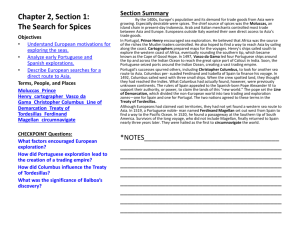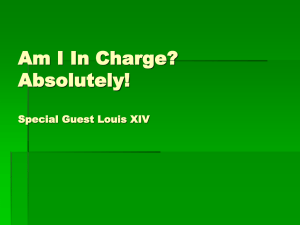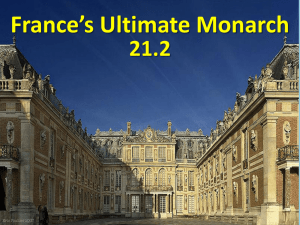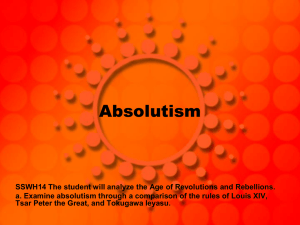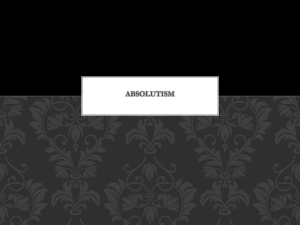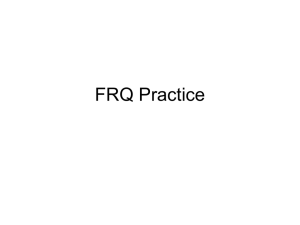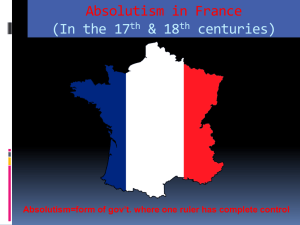Section 1: The Renaissance in Italy
advertisement
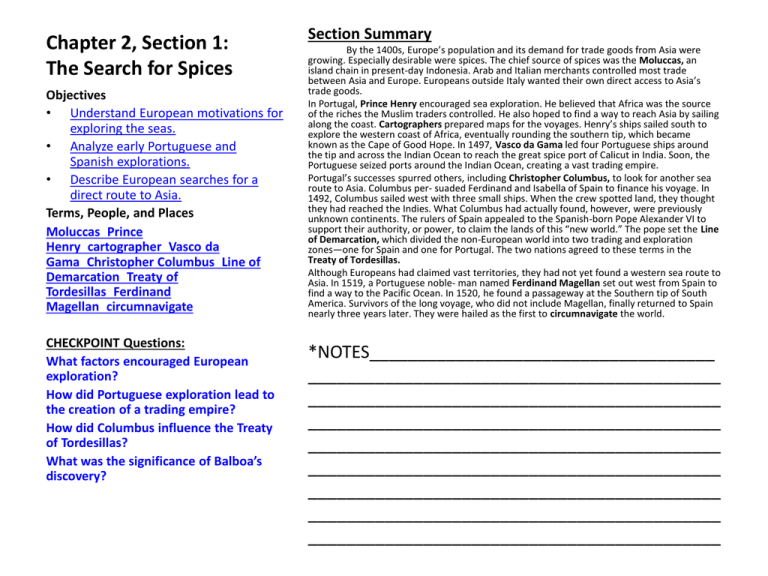
Chapter 2, Section 1: The Search for Spices Objectives • Understand European motivations for exploring the seas. • Analyze early Portuguese and Spanish explorations. • Describe European searches for a direct route to Asia. Terms, People, and Places Moluccas Prince Henry cartographer Vasco da Gama Christopher Columbus Line of Demarcation Treaty of Tordesillas Ferdinand Magellan circumnavigate CHECKPOINT Questions: What factors encouraged European exploration? How did Portuguese exploration lead to the creation of a trading empire? How did Columbus influence the Treaty of Tordesillas? What was the significance of Balboa’s discovery? Section Summary By the 1400s, Europe’s population and its demand for trade goods from Asia were growing. Especially desirable were spices. The chief source of spices was the Moluccas, an island chain in present-day Indonesia. Arab and Italian merchants controlled most trade between Asia and Europe. Europeans outside Italy wanted their own direct access to Asia’s trade goods. In Portugal, Prince Henry encouraged sea exploration. He believed that Africa was the source of the riches the Muslim traders controlled. He also hoped to find a way to reach Asia by sailing along the coast. Cartographers prepared maps for the voyages. Henry’s ships sailed south to explore the western coast of Africa, eventually rounding the southern tip, which became known as the Cape of Good Hope. In 1497, Vasco da Gama led four Portuguese ships around the tip and across the Indian Ocean to reach the great spice port of Calicut in India. Soon, the Portuguese seized ports around the Indian Ocean, creating a vast trading empire. Portugal’s successes spurred others, including Christopher Columbus, to look for another sea route to Asia. Columbus per- suaded Ferdinand and Isabella of Spain to finance his voyage. In 1492, Columbus sailed west with three small ships. When the crew spotted land, they thought they had reached the Indies. What Columbus had actually found, however, were previously unknown continents. The rulers of Spain appealed to the Spanish-born Pope Alexander VI to support their authority, or power, to claim the lands of this “new world.” The pope set the Line of Demarcation, which divided the non-European world into two trading and exploration zones—one for Spain and one for Portugal. The two nations agreed to these terms in the Treaty of Tordesillas. Although Europeans had claimed vast territories, they had not yet found a western sea route to Asia. In 1519, a Portuguese noble- man named Ferdinand Magellan set out west from Spain to find a way to the Pacific Ocean. In 1520, he found a passageway at the Southern tip of South America. Survivors of the long voyage, who did not include Magellan, finally returned to Spain nearly three years later. They were hailed as the first to circumnavigate the world. *NOTES____________________________________ ___________________________________________ ___________________________________________ ___________________________________________ ___________________________________________ ___________________________________________ ___________________________________________ ___________________________________________ ___________________________________________ Chapter 3, Section 1: Conquest in the Americas Objectives • Analyze the results of the first encounters between the Spanish and Native Americans. • Explain how Cortés and Pizarro gained control of the Aztec and Incan empires. • Understand the short-term and longterm effects of the Spanish on the peoples of the Americas. Terms, People, and Places conquistador immunity Hernán Cortés Tenochtitlán Malinche alliance Mo ctezuma Francisco Pizarro civil war CHECKPOINT Questions: How did Spanish conquistadors treat the Taínos? What impact did the Aztecs’ religious beliefs have on Cortés’s approach to Tenochtitlán? What factors encouraged Spanish success in Peru? In what ways did Native Americans resist Europeans? Section Summary In 1492, Christopher Columbus reached the Caribbean islands now called the West Indies. Columbus’ first meeting with Native Americans there began a recurring cycle of encounter, conquest, and death across the Western Hemisphere. Columbus first encountered the Taíno people and claimed their land for Spain, taking prisoners back with him. A wave of Spanish conquistadors, or conquerors, followed. Ultimately, hundreds of Spanish overpowered millions of native people, using superior weapons and horses. Unknowingly, the Spanish also brought diseases like smallpox, measles, and influenza. This wiped out village after vil- lage of Native Americans, who had no immunity, or resistance. One of the earliest explorers, Hernán Cortés, reached Mexico in 1519 and moved toward the Aztec capital, Tenochtitlán. Cortés was aided by an Indian woman, Malinche, who helped him form alliances with native peoples previously conquered by the Aztecs. Aztec ruler Moctezuma tried but failed to keep Cortés from coming to Tenochtitlán. Cortés later imprisoned Moctezuma and compelled him to sign over lands and treasure to the Spanish. Cortés was driven out, but he returned in 1521 and destroyed Tenochtitlán. Another Spanish adventurer, Francisco Pizarro, sought riches from Peru’s Inca empire. Pizarro reached Peru in 1532. The Inca ruler, Atahualpa, had just won a civil war, or conflict between peo- ple of the same nation. Pizarro captured Atahualpa and demanded a huge ransom. This was paid, but Pizarro had the Inca ruler killed anyway. Spanish forces overran Inca lands, adding much of South America to the Spanish empire. Pizarro was killed a few years later by a rival Spanish group. Spain’s impact on the Americas was immense. The Spanish took vast fortunes in gold and silver, making Spain the greatest power of Europe. They opened sea routes that connected two hemispheres and opened an exchange of goods, people, and ideas. However, they also brought disease and death to Native Americans. Many survivors con- verted to Christianity, seeking hope. Others, like the Maya, resisted Spanish influence by preserving their own religion, language, and culture, and ultimately leaving their imprint on Latin America. *NOTES____________________________________ ___________________________________________ ___________________________________________ ___________________________________________ ___________________________________________ ___________________________________________ ___________________________________________ ___________________________________________ ___________________________________________ Chapter 3, Section 4: The Atlantic Slave Trade Objectives • Explain how triangular trade worked. • Understand the nature of the Middle Passage and describe its effects. • Analyze the impact of the Atlantic slave trade. Terms, People, and Places Olaudah Equiano triangular trade Middle Passage mutiny CHECKPOINT Questions: How did triangular trade affect colonial economies? How did enslaved Africans resist captivity? How did the slave trade affect Africans? Section Summary Empires grew in the 1500s, and trade increased between the Americas and other parts of the world. Spain was the first major power to import slaves into its South American colonies, but slave trade grew as other European powers established colonies. Slave labor became a way to gain greater profits, but at the expense of millions of lives. The trade of slaves became known as triangular trade, a series of Atlantic sea routes joining Europe, Africa, and the Americas. On the first leg of the triangle, merchant ships brought European goods, such as guns and cloth, to Africa, where they were traded for slaves. On the second leg, known as the Middle Passage, slaves were brought to the Americas, where they were traded for sugar, molasses, and cotton from European-owned plantations. On the final leg, these products were traded for other colonial goods, such as furs and salt fish, then shipped to Europe, where they were traded for European goods. The Middle Passage was a horrifying journey for Africans. Olaudah Equiano, who was sold into slavery as an 11-year-old in the 1750s, wrote of his experiences. During the Middle Passage, slaves were captured, bound, and forced to walk as much as a thou- sand miles. Many died on the way. Those who lived were restrained in holding pens in African port cities until European ships arrived. Hundreds were crammed below deck for the three-week to threemonth voyages. Some committed suicide. Many died from disease, brutality, or other dangers, like storms, pirate raids, and mutinies, or revolts, by captives trying to return home. The triangular trade continued, in part, because it was so prof- itable. It brought riches to merchants and traders, helped the colo- nial economies succeed, and helped European and American port cities grow. However, for Africans the outcome was devastating. African societies were torn apart, and lives were cut short or brutal- ized. By the mid-1800s, when the slave trade finally ended, an esti- mated 11 million Africans had been brought to the Americas, and another 2 million had died during the Middle Passage. *NOTES____________________________________ ___________________________________________ ___________________________________________ ___________________________________________ ___________________________________________ ___________________________________________ ___________________________________________ ___________________________________________ ___________________________________________ Chapter 4, Section 2: France Under Louis XIV Objectives • Understand how Henry IV rebuilt France after the wars of religion. • Explain how Louis XIV became an absolute monarch. • Describe how Versailles was a symbol of royal power. • Identify Louis XIV’s successes and failures. Terms, People, and Places Huguenots Henry IV Edict of Nantes Cardinal Richelieu Louis XIV intendant Jean-Baptiste Colbert Versailles levée balance of power CHECKPOINT Questions: What rights did the Edict of Nantes extend to Huguenots? Why did Louis XIV choose the sun as his symbol? How did Louis XIV secure support from the nobility? How did Louis’s actions weaken France’s economy? Section Summary In the late 1500s, France was torn apart by religious conflict between French Protestants, called Huguenots, and Catholics. In an event called the St. Bartholomew’s Day Massacre, thousands of Huguenots were slaughtered. In 1598, King Henry IV issued the Edict of Nantes to protect Protestants. This granted the Huguenots religious toleration and other freedoms. After Henry’s assassination in 1610, his nine-year-old son, Louis XIII, inherited the throne. Louis appointed Cardinal Richelieu as his chief minister. Richelieu sought to strengthen royal power by crush- ing any groups that did not bow to royal authority. In 1643, five- year-old Louis XIV inherited the French throne. When his chief minister died, Louis XIV resolved to take complete control of the government. He believed in his divine right to rule and even called himself the Sun King to symbolize his vital role within the nation. Louis XIV expanded the royal government and appointed intendants—royal officials who collected taxes, recruited soldiers, and carried out his policies in the provinces. To fuel the country’s econ- omy, Louis’s finance minister, Jean Baptiste Colbert, expanded com- merce and trade. Taxes helped finance the king’s extravagant lifestyle. Outside Paris, Louis XIV transformed a royal hunting lodge into the grand palace of Versailles. The palace represented the king’s great power and wealth. Elaborate court ceremonies were held to emphasize the king’s importance. For example, during the ritual known as the levée, or rising, high-ranking nobles would compete for the honor of handing the king his shoes. The purpose was to keep the nobles in Versailles to gain their support and prevent them from getting too powerful. Under Louis XIV, France became the strongest state in Europe. However, the country’s prosperity began to erode. This loss of wealth was caused by some of Louis’s decisions. He fought costly wars to extend French borders, but rival rulers resisted in order to maintain the balance of power. Louis also revoked the Edict of Nantes, driving over 100,000 hard-working and prosperous Huguenots out of France. *NOTES____________________________________ ___________________________________________ ___________________________________________ ___________________________________________ ___________________________________________ ___________________________________________ ___________________________________________ ___________________________________________ ___________________________________________ Chapter 5, Section 1: Philosophy in the Age of Reason Objectives • Explain how science led to the Enlightenment. • Compare the ideas of Hobbes and Locke. • Identify the beliefs and contributions of the philosophes. • Summarize how economic thinking changed during this time. Terms, People, and Places natural law Thomas Hobbes John Locke social contract natural right philosophe Montesquieu Voltaire Diderot Rousseau laissez faire Adam Smith CHECKPOINT Questions: What convinced educated Europeans to accept the power of reason? How did Hobbes and Locke differ in their views on the role of government? What topics were addressed by the philosophes in their Encyclopedia articles? Why did Smith support laissez faire? Section Summary In the 1500s and 1600s, the Scientific Revolution introduced reason and scientific method as the basis of knowledge, changing the way people looked at the world. In the 1700s, scientific successes, such as a vaccine against smallpox, convinced educated Europeans of the power of human reason. Natural law—rules discovered by reason— could be used to study human behavior and solve society’s problems. In this way, the Scientific Revolution sparked another revolution in thinking, known as the Enlightenment. The ideas of Thomas Hobbes and John Locke, two seventeenth- century English thinkers, were key to the Enlightenment. Hobbes argued that people are “brutish” by nature, and therefore need to be controlled by an absolute monarchy. According to Hobbes, people enter into a social contract with their government, giving up their freedom in exchange for an organized society. In contrast, Locke thought that people are basically reasonable and moral. He also believed that people have certain natural rights, including the right to life, liberty, and property. Locke rejected absolute monarchy, believing that the best kind of government had limited power. In fact, Locke felt that people could overthrow a government if it vio- lated their natural rights. In France, Enlightenment thinkers called philosophes believed that the use of reason could lead to reforms in government, law, and soci- ety. Baron de Montesquieu proposed the ideas of separation of pow- ers and of checks and balances as a way to protect liberty. His ideas would deeply affect the Framers of the United States Constitution. With his biting wit, Voltaire exposed abuses of power and defended the principle of freedom of speech. Denis Diderot edited a 28-volume Encyclopedia. This work included articles on human knowledge, explaining new ideas on topics such as government, philosophy, and religion. Jean-Jacques Rousseau believed that the good of the com- munity should be placed above individual interests. However, the Enlightenment slogan “free and equal” did not apply to women. Other thinkers, including Adam Smith, focused on using natural laws for economic reform. They rejected government regulation of the economy and instead urged the policy of laissez faire. *NOTES____________________________________ ___________________________________________ ___________________________________________ ___________________________________________ ___________________________________________ ___________________________________________ ___________________________________________ ___________________________________________ ___________________________________________

